brake sensor MERCEDES-BENZ GL-Class 2014 X166 Owner's Manual
[x] Cancel search | Manufacturer: MERCEDES-BENZ, Model Year: 2014, Model line: GL-Class, Model: MERCEDES-BENZ GL-Class 2014 X166Pages: 462, PDF Size: 32.46 MB
Page 8 of 462
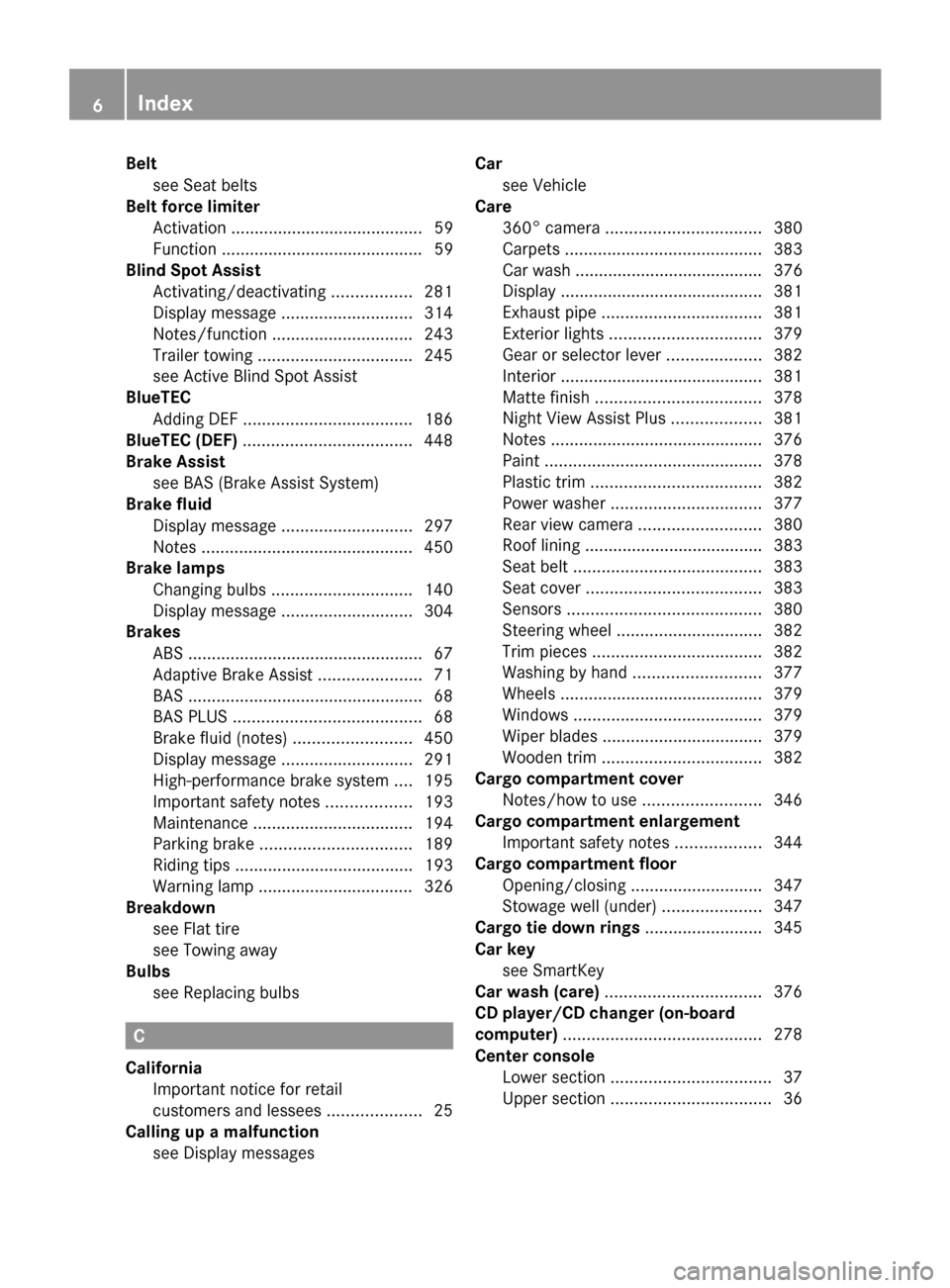
Belt
see Seat belts
Belt force limiter
Activation ......................................... 59
Function ........................................... 59
Blind Spot Assist
Activating/deactivating .................281
Display message ............................ 314
Notes/function .............................. 243
Trailer towing ................................. 245
see Active Blind Spot Assist
BlueTEC
Adding DEF .................................... 186
BlueTEC (DEF) .................................... 448
Brake Assist see BAS (Brake Assist System)
Brake fluid
Display message ............................ 297
Notes ............................................. 450
Brake lamps
Changing bulbs .............................. 140
Display message ............................ 304
Brakes
ABS .................................................. 67
Adaptive Brake Assist ......................71
BAS .................................................. 68
BAS PLUS ........................................ 68
Brake fluid (notes) .........................450
Display message ............................ 291
High-performance brake system ....195
Important safety notes ..................193
Maintenance .................................. 194
Parking brake ................................ 189
Riding tips ...................................... 193
Warning lamp ................................. 326
Breakdown
see Flat tire
see Towing away
Bulbs
see Replacing bulbs C
California Important notice for retail
customers and lessees ....................25
Calling up a malfunction
see Display messages Car
see Vehicle
Care
360° camera ................................. 380
Carpets .......................................... 383
Car wash ........................................ 376
Display ........................................... 381
Exhaust pipe .................................. 381
Exterior lights ................................ 379
Gear or selector lever ....................382
Interior ........................................... 381
Matte finish ................................... 378
Night View Assist Plus ...................381
Notes ............................................. 376
Paint .............................................. 378
Plastic trim .................................... 382
Power washer ................................ 377
Rear view camera .......................... 380
Roof lining ...................................... 383
Seat belt ........................................ 383
Seat cover ..................................... 383
Sensors ......................................... 380
Steering wheel ............................... 382
Trim pieces .................................... 382
Washing by hand ........................... 377
Wheels ........................................... 379
Windows ........................................ 379
Wiper blades .................................. 379
Wooden trim .................................. 382
Cargo compartment cover
Notes/how to use .........................346
Cargo compartment enlargement
Important safety notes ..................344
Cargo compartment floor
Opening/closing ............................ 347
Stowage well (under) .....................347
Cargo tie down rings .........................345
Car key see SmartKey
Car wash (care) ................................. 376
CD player/CD changer (on-board
computer) .......................................... 278
Center console Lower section .................................. 37
Upper section .................................. 366
Index
Page 17 of 462
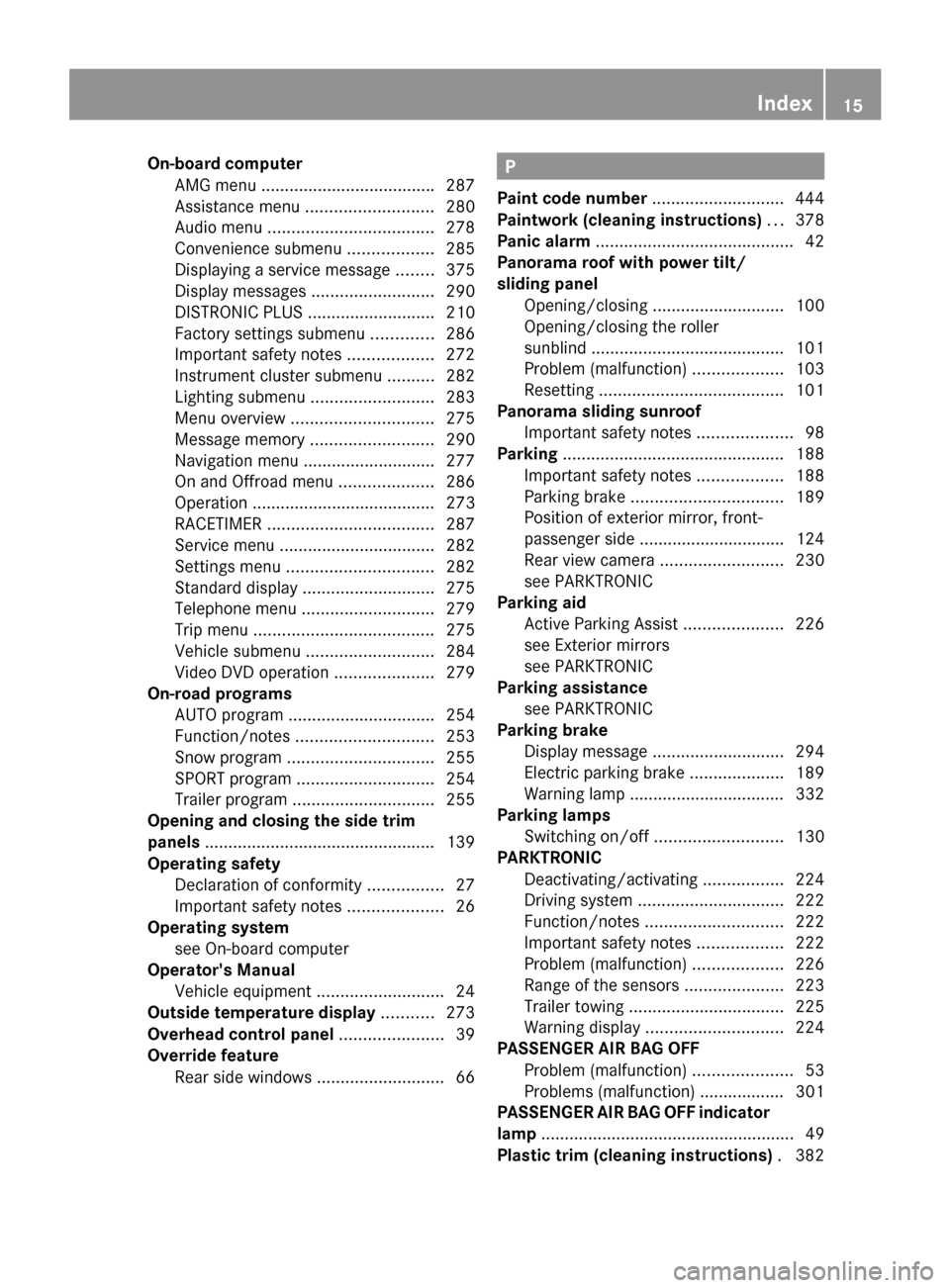
On-board computer
AMG menu .................................... .287
Assistance menu ........................... 280
Audio menu ................................... 278
Convenience submenu ..................285
Displaying a service message ........375
Display messages ..........................290
DISTRONIC PLUS ........................... 210
Factory settings submenu .............286
Important safety notes ..................272
Instrument cluster submenu ..........282
Lighting submenu .......................... 283
Menu overview .............................. 275
Message memory .......................... 290
Navigation menu ............................ 277
On and Offroad menu ....................286
Operation ....................................... 273
RACETIMER ................................... 287
Service menu ................................. 282
Settings menu ............................... 282
Standard displa y............................ 275
Telephone menu ............................ 279
Trip menu ...................................... 275
Vehicle submenu ........................... 284
Video DVD operation .....................279
On-road programs
AUTO program ............................... 254
Function/notes ............................. 253
Snow program ............................... 255
SPORT program ............................. 254
Trailer program .............................. 255
Opening and closing the side trim
panels ................................................. 139
Operating safety Declaration of conformity ................27
Important safety notes ....................26
Operating system
see On-board computer
Operator's Manual
Vehicle equipment ...........................24
Outside temperature display ...........273
Overhead control panel ......................39
Override feature Rear side windows ...........................66 P
Paint code number ............................444
Paintwork (cleaning instructions) ...378
Panic alarm .......................................... 42
Panorama roof with power tilt/
sliding panel
Opening/closing ............................ 100
Opening/closing the roller
sunblind ......................................... 101
Problem (malfunction) ...................103
Resetting ....................................... 101
Panorama sliding sunroof
Important safety notes ....................98
Parking ............................................... 188
Important safety notes ..................188
Parking brake ................................ 189
Position of exterior mirror, front-
passenger side ............................... 124
Rear view camera .......................... 230
see PARKTRONIC
Parking aid
Active Parking Assist .....................226
see Exterior mirrors
see PARKTRONIC
Parking assistance
see PARKTRONIC
Parking brake
Display message ............................ 294
Electric parking brake ....................189
Warning lamp ................................. 332
Parking lamps
Switching on/off ........................... 130
PARKTRONIC
Deactivating/activating .................224
Driving system ............................... 222
Function/notes ............................. 222
Important safety notes ..................222
Problem (malfunction) ...................226
Range of the sensors .....................223
Trailer towing ................................. 225
Warning displa y............................. 224
PASSENGER AIR BAG OFF
Problem (malfunction) .....................53
Problems (malfunction) .................. 301
PASSENGER AIR BAG OFF indicator
lamp ...................................................... 49
Plastic trim (cleaning instructions) .382 Index
15
Page 18 of 462
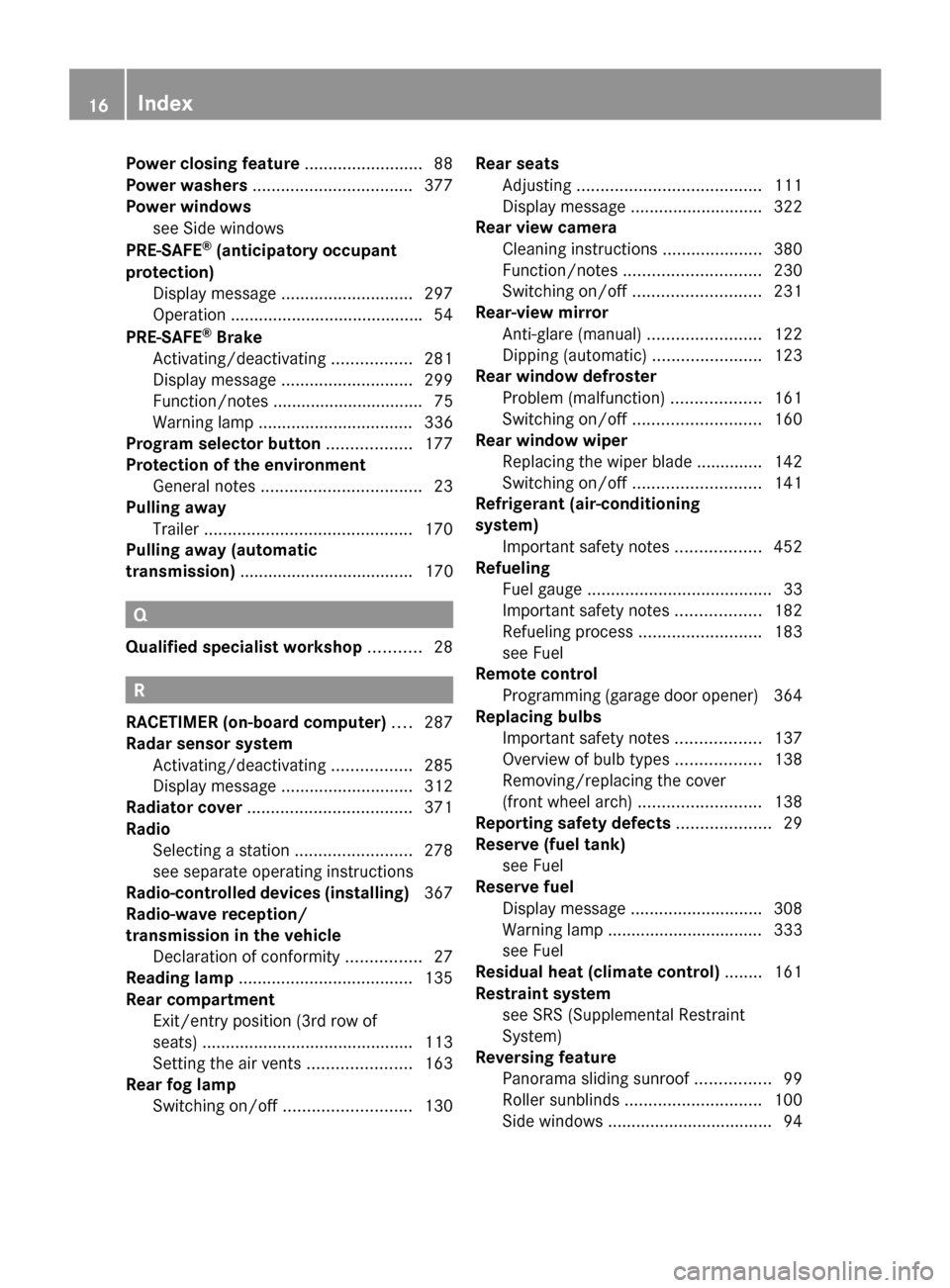
Power closing feature
.........................88
Power washers .................................. 377
Power windows see Side windows
PRE-SAFE ®
(anticipatory occupant
protection) Display message ............................ 297
Operation ........................................ .54
PRE-SAFE ®
Brake
Activating/deactivating .................281
Display message ............................ 299
Function/notes ................................ 75
Warning lamp ................................. 336
Program selector button ..................177
Protection of the environment General notes .................................. 23
Pulling away
Trailer ............................................ 170
Pulling away (automatic
transmission) ..................................... 170 Q
Qualified specialist workshop ...........28 R
RACETIMER (on-board computer) ....287
Radar sensor system Activating/deactivating .................285
Display message ............................ 312
Radiator cover ................................... 371
Radio Selecting a station .........................278
see separate operating instructions
Radio-controlled devices (installing) 367
Radio-wave reception/
transmission in the vehicle
Declaration of conformity ................27
Reading lamp ..................................... 135
Rear compartment Exit/entry position (3rd row of
seats) ............................................ .113
Setting the air vents ......................163
Rear fog lamp
Switching on/off ........................... 130Rear seats
Adjusting ....................................... 111
Display message ............................ 322
Rear view camera
Cleaning instructions .....................380
Function/notes ............................. 230
Switching on/off ........................... 231
Rear-view mirror
Anti-glare (manual) ........................122
Dipping (automatic) .......................123
Rear window defroster
Problem (malfunction) ...................161
Switching on/off ........................... 160
Rear window wiper
Replacing the wiper blade .............. 142
Switching on/off ........................... 141
Refrigerant (air-conditioning
system)
Important safety notes ..................452
Refueling
Fuel gauge ....................................... 33
Important safety notes ..................182
Refueling proces s.......................... 183
see Fuel
Remote control
Programming (garage door opener) 364
Replacing bulbs
Important safety notes ..................137
Overview of bulb type s.................. 138
Removing/replacing the cover
(front wheel arch) .......................... 138
Reporting safety defects ....................29
Reserve (fuel tank) see Fuel
Reserve fuel
Display message ............................ 308
Warning lamp ................................. 333
see Fuel
Residual heat (climate control) ........161
Restraint system see SRS (Supplemental Restraint
System)
Reversing feature
Panorama sliding sunroo f................ 99
Roller sunblinds ............................. 100
Side windows ................................... 9416
Index
Page 19 of 462
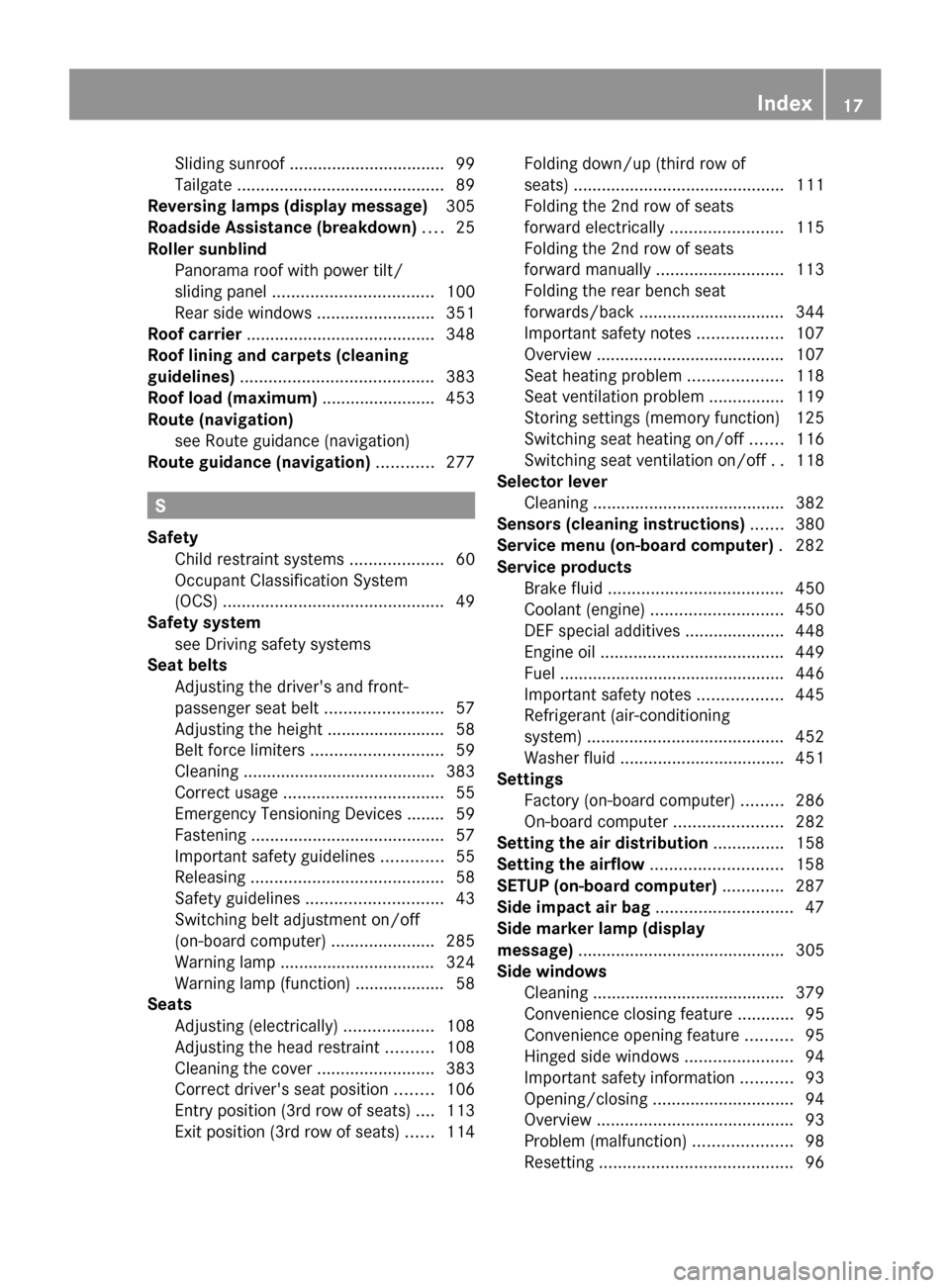
Sliding sunroof
................................. 99
Tailgate ............................................ 89
Reversing lamps (display message) 305
Roadside Assistance (breakdown) ....25
Roller sunblind Panorama roof with power tilt/
sliding pane l.................................. 100
Rear side windows .........................351
Roof carrier ........................................ 348
Roof lining and carpets (cleaning
guidelines) ......................................... 383
Roof load (maximum) ........................453
Route (navigation) see Route guidance (navigation)
Route guidance (navigation) ............277 S
Safety Child restraint systems ....................60
Occupant Classification System
(OCS) ............................................... 49
Safety system
see Driving safety systems
Seat belts
Adjusting the driver's and front-
passenger seat belt .........................57
Adjusting the height ......................... 58
Belt force limiters ............................ 59
Cleaning ......................................... 383
Correct usage .................................. 55
Emergency Tensioning Devices ....... .59
Fastening ......................................... 57
Important safety guidelines .............55
Releasing ......................................... 58
Safety guidelines ............................. 43
Switching belt adjustment on/off
(on-board computer) ......................285
Warning lamp ................................. 324
Warning lamp (function) ................... 58
Seats
Adjusting (electrically) ...................108
Adjusting the head restraint ..........108
Cleaning the cover .........................383
Correct driver's seat position ........106
Entry position (3rd row of seats) ....113
Exit position (3rd row of seats) ......114 Folding down/up (third row of
seats) ............................................
.111
Folding the 2nd row of seats
forward electrically ........................115
Folding the 2nd row of seats
forward manually ........................... 113
Folding the rear bench seat
forwards/back ............................... 344
Important safety notes ..................107
Overview ........................................ 107
Seat heating problem ....................118
Seat ventilation problem ................119
Storing settings (memory function) 125
Switching seat heating on/off .......116
Switching seat ventilation on/off ..118
Selector lever
Cleaning ......................................... 382
Sensors (cleaning instructions) .......380
Service menu (on-board computer) .282
Service products Brake fluid ..................................... 450
Coolant (engine) ............................ 450
DEF special additives .....................448
Engine oil ....................................... 449
Fuel ................................................ 446
Important safety notes ..................445
Refrigerant (air-conditioning
system) .......................................... 452
Washer fluid .................................. .451
Settings
Factory (on-board computer) .........286
On-board computer .......................282
Setting the air distribution ...............158
Setting the airflow ............................158
SETUP (on-board computer) .............287
Side impact air bag .............................47
Side marker lamp (display
message) ............................................ 305
Side windows Cleaning ......................................... 379
Convenience closing feature ............95
Convenience opening feature ..........95
Hinged side windows .......................94
Important safety information ...........93
Opening/closing .............................. 94
Overview .......................................... 93
Problem (malfunction) .....................98
Resetting ......................................... 96 Index
17
Page 25 of 462
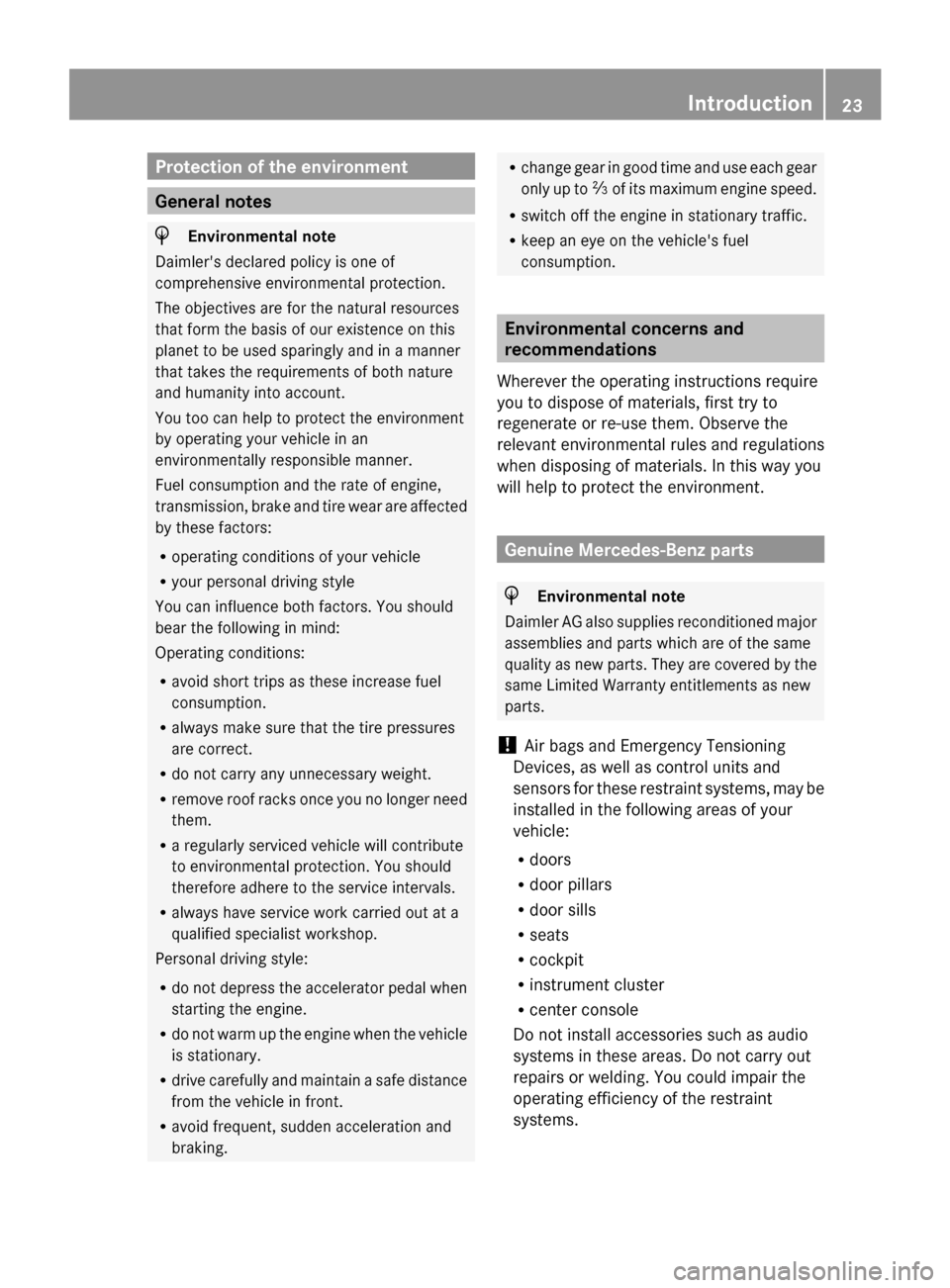
Protection of the environment
General notes
H
Environmental note
Daimler's declared policy is one of
comprehensive environmental protection.
The objectives are for the natural resources
that form the basis of our existence on this
planet to be used sparingly and in a manner
that takes the requirements of both nature
and humanity into account.
You too can help to protect the environment
by operating your vehicle in an
environmentally responsible manner.
Fuel consumption and the rate of engine,
transmission, brake and tire wear are affected
by these factors:
R operating conditions of your vehicle
R your personal driving style
You can influence both factors. You should
bear the following in mind:
Operating conditions:
R avoid short trips as these increase fuel
consumption.
R always make sure that the tire pressures
are correct.
R do not carry any unnecessary weight.
R remove roof racks once you no longer need
them.
R a regularly serviced vehicle will contribute
to environmental protection. You should
therefore adhere to the service intervals.
R always have service work carried out at a
qualified specialist workshop.
Personal driving style:
R do not depress the accelerator pedal when
starting the engine.
R do not warm up the engine when the vehicle
is stationary.
R drive carefully and maintain a safe distance
from the vehicle in front.
R avoid frequent, sudden acceleration and
braking. R
change gear in good time and use each gear
only up to Ôof its maximum engine speed.
R switch off the engine in stationary traffic.
R keep an eye on the vehicle's fuel
consumption. Environmental concerns and
recommendations
Wherever the operating instructions require
you to dispose of materials, first try to
regenerate or re-use them. Observe the
relevant environmental rules and regulations
when disposing of materials. In this way you
will help to protect the environment. Genuine Mercedes-Benz parts
H
Environmental note
Daimler AG also supplies reconditioned major
assemblies and parts which are of the same
quality as new parts. They are covered by the
same Limited Warranty entitlements as new
parts.
! Air bags and Emergency Tensioning
Devices, as well as control units and
sensors for these restraint systems, may be
installed in the following areas of your
vehicle:
R doors
R door pillars
R door sills
R seats
R cockpit
R instrument cluster
R center console
Do not install accessories such as audio
systems in these areas. Do not carry out
repairs or welding. You could impair the
operating efficiency of the restraint
systems. Introduction
23 Z
Page 56 of 462
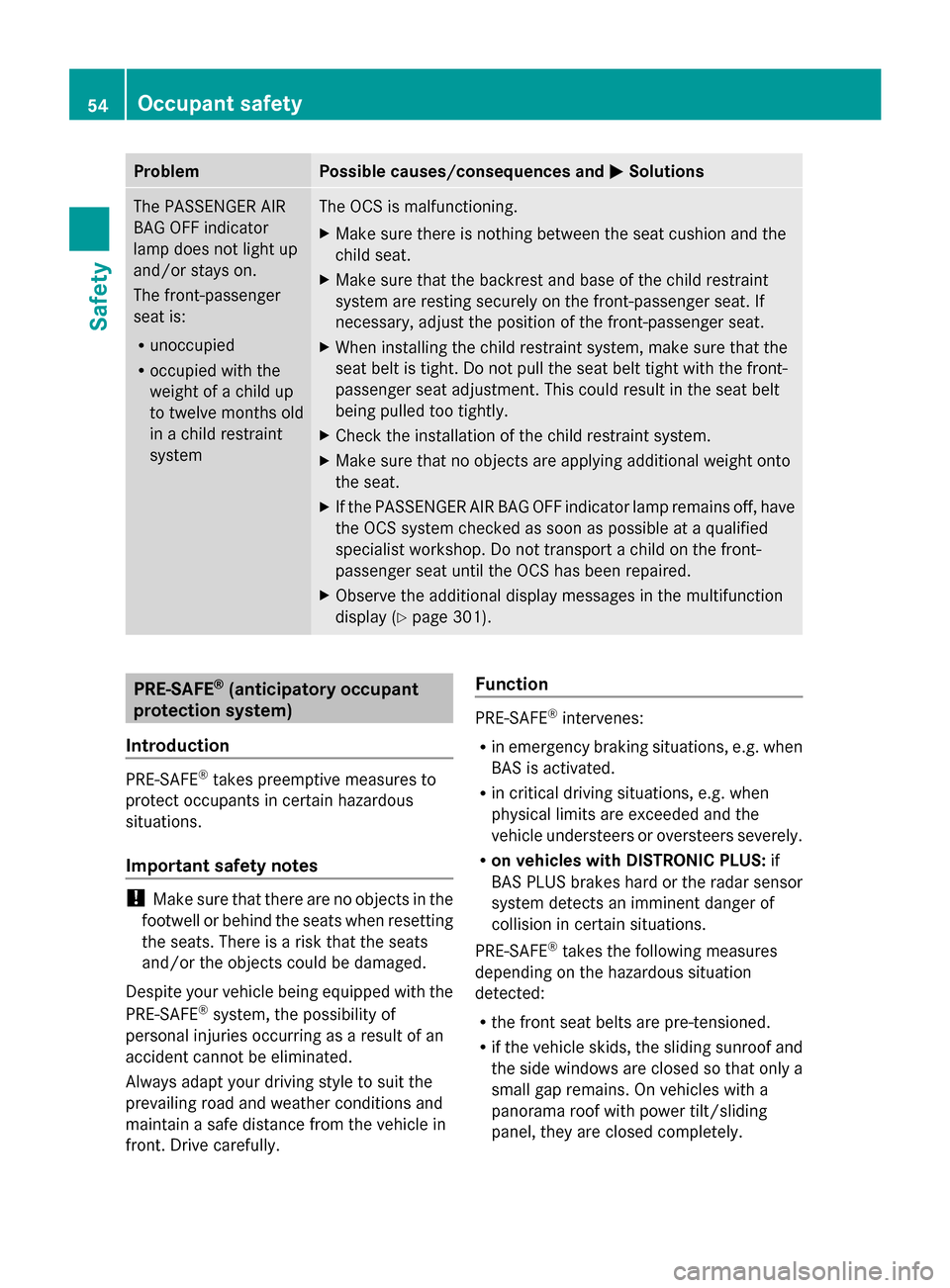
Problem Possible causes/consequences and
M
MSolutions The PASSENGER AIR
BAG OFF indicator
lamp does not light up
and/or stays on.
The front-passenger
seat is:
R unoccupied
R occupied with the
weight of a child up
to twelve months old
in a child restraint
system The OCS is malfunctioning.
X
Make sure there is nothing between the seat cushion and the
child seat.
X Make sure that the backrest and base of the child restraint
system are resting securely on the front-passenger seat. If
necessary, adjust the position of the front-passenger seat.
X When installing the child restraint system, make sure that the
seat belt is tight. Do not pull the seat belt tight with the front-
passenger seat adjustment. This could result in the seat belt
being pulled too tightly.
X Check the installation of the child restraint system.
X Make sure that no objects are applying additional weight onto
the seat.
X If the PASSENGER AIR BAG OFF indicator lamp remains off, have
the OCS system checked as soon as possible at a qualified
specialist workshop. Do not transport a child on the front-
passenger seat until the OCS has been repaired.
X Observe the additional display messages in the multifunction
display (Y page 301). PRE-SAFE
®
(anticipatory occupant
protection system)
Introduction PRE-SAFE
®
takes preemptive measures to
protect occupants in certain hazardous
situations.
Important safety notes !
Make sure that there are no objects in the
footwell or behind the seats when resetting
the seats. There is a risk that the seats
and/or the objects could be damaged.
Despite your vehicle being equipped with the
PRE-SAFE ®
system, the possibility of
personal injuries occurring as a result of an
accident cannot be eliminated.
Always adapt your driving style to suit the
prevailing road and weather conditions and
maintain a safe distance from the vehicle in
front. Drive carefully. Function PRE-SAFE
®
intervenes:
R in emergency braking situations, e.g. when
BAS is activated.
R in critical driving situations, e.g. when
physical limits are exceeded and the
vehicle understeers or oversteers severely.
R on vehicles with DISTRONIC PLUS: if
BAS PLUS brakes hard or the radar sensor
system detects an imminent danger of
collision in certain situations.
PRE-SAFE ®
takes the following measures
depending on the hazardous situation
detected:
R the front seat belts are pre-tensioned.
R if the vehicle skids, the sliding sunroof and
the side windows are closed so that only a
small gap remains. On vehicles with a
panorama roof with power tilt/sliding
panel, they are closed completely. 54
Occupant safetySafety
Page 70 of 462
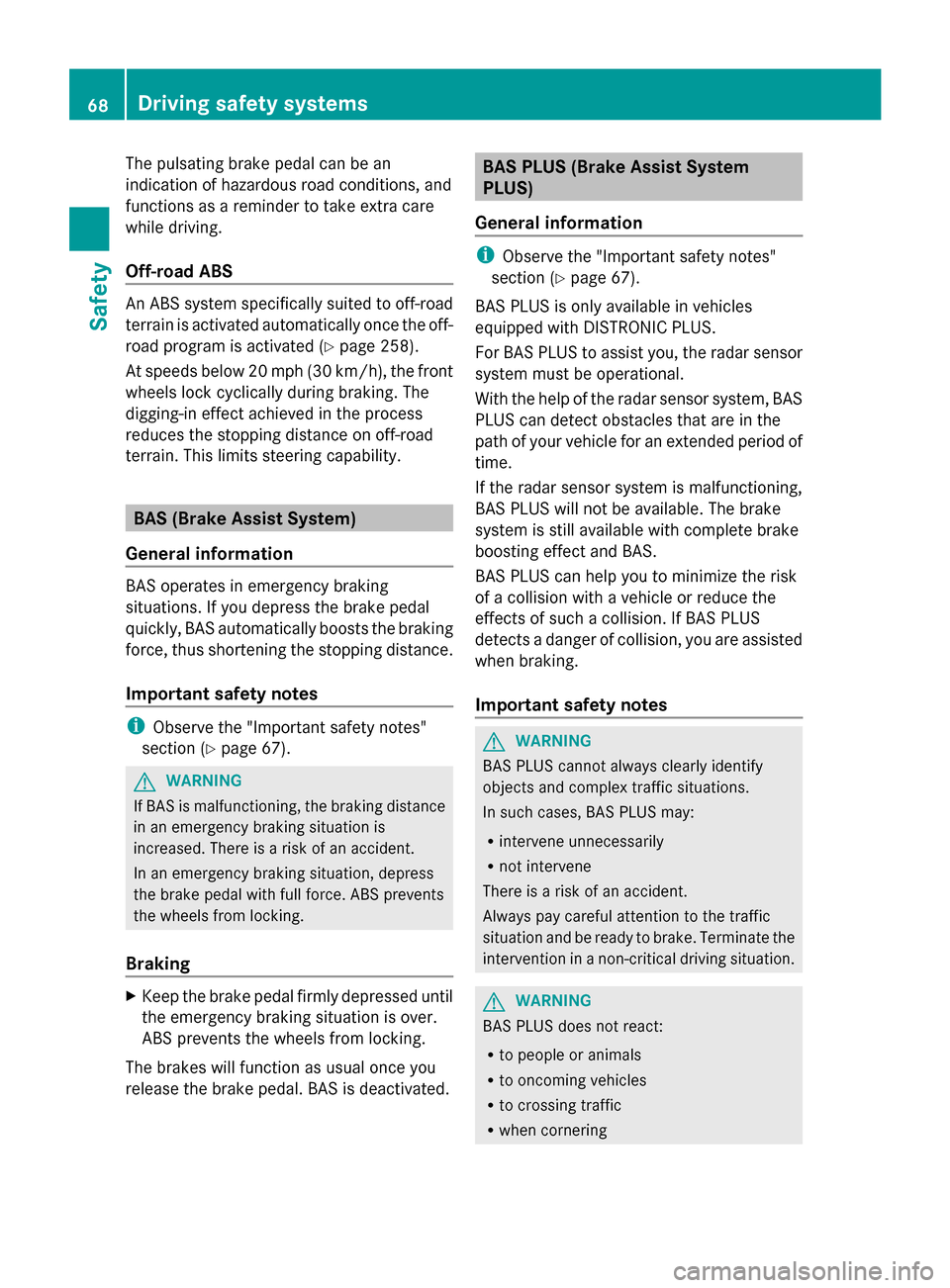
The pulsating brake pedal can be an
indication of hazardous road conditions, and
functions as a reminder to take extra care
while driving.
Off-road ABS An ABS system specifically suited to off-road
terrain is activated automatically once the off-
road program is activated (Y page 258).
At speeds below 20 mph (30 km/h), the front
wheels lock cyclically during braking. The
digging-in effect achieved in the process
reduces the stopping distance on off-road
terrain. This limits steering capability. BAS (Brake Assist System)
General information BAS operates in emergency braking
situations. If you depress the brake pedal
quickly, BAS automatically boosts the braking
force, thus shortening the stopping distance.
Important safety notes i
Observe the "Important safety notes"
section (Y page 67). G
WARNING
If BAS is malfunctioning, the braking distance
in an emergency braking situation is
increased. There is a risk of an accident.
In an emergency braking situation, depress
the brake pedal with full force. ABS prevents
the wheels from locking.
Braking X
Keep the brake pedal firmly depressed until
the emergency braking situation is over.
ABS prevents the wheels from locking.
The brakes will function as usual once you
release the brake pedal. BAS is deactivated. BAS PLUS (Brake Assist System
PLUS)
General information i
Observe the "Important safety notes"
section (Y page 67).
BAS PLUS is only available in vehicles
equipped with DISTRONIC PLUS.
For BAS PLUS to assist you, the radar sensor
system must be operational.
With the help of the radar sensor system, BAS
PLUS can detect obstacles that are in the
path of your vehicle for an extended period of
time.
If the radar sensor system is malfunctioning,
BAS PLUS will not be available. The brake
system is still available with complete brake
boosting effect and BAS.
BAS PLUS can help you to minimize the risk
of a collision with a vehicle or reduce the
effects of such a collision. If BAS PLUS
detects a danger of collision, you are assisted
when braking.
Important safety notes G
WARNING
BAS PLUS cannot always clearly identify
objects and complex traffic situations.
In such cases, BAS PLUS may:
R intervene unnecessarily
R not intervene
There is a risk of an accident.
Always pay careful attention to the traffic
situation and be ready to brake. Terminate the
intervention in a non-critical driving situation. G
WARNING
BAS PLUS does not react:
R to people or animals
R to oncoming vehicles
R to crossing traffic
R when cornering 68
Driving safety systemsSafety
Page 71 of 462
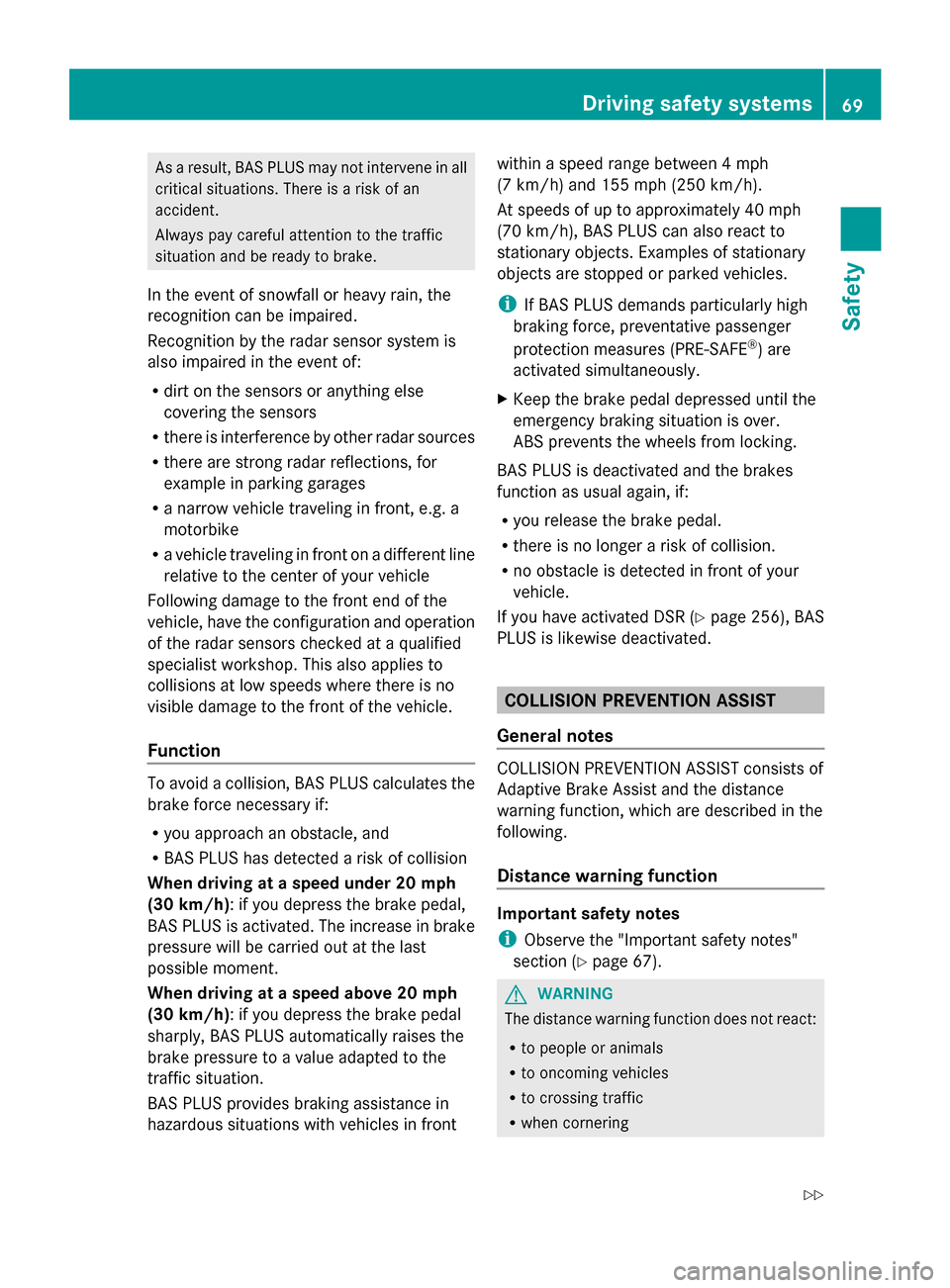
As a result, BAS PLUS may not intervene in all
critical situations. There is a risk of an
accident.
Always pay careful attention to the traffic
situation and be ready to brake.
In the event of snowfall or heavy rain, the
recognition can be impaired.
Recognition by the radar sensor system is
also impaired in the event of:
R dirt on the sensors or anything else
covering the sensors
R there is interference by other radar sources
R there are strong radar reflections, for
example in parking garages
R a narrow vehicle traveling in front, e.g. a
motorbike
R a vehicle traveling in front on a different line
relative to the center of your vehicle
Following damage to the front end of the
vehicle, have the configuration and operation
of the radar sensors checked at a qualified
specialist workshop. This also applies to
collisions at low speeds where there is no
visible damage to the front of the vehicle.
Function To avoid a collision, BAS PLUS calculates the
brake force necessary if:
R you approach an obstacle, and
R BAS PLUS has detected a risk of collision
When driving at a speed under 20 mph
(30 km/h): if you depress the brake pedal,
BAS PLUS is activated. The increase in brake
pressure will be carried out at the last
possible moment.
When driving at a speed above 20 mph
(30 km/h): if you depress the brake pedal
sharply, BAS PLUS automatically raises the
brake pressure to a value adapted to the
traffic situation.
BAS PLUS provides braking assistance in
hazardous situations with vehicles in front within a speed range between 4 mph
(7 km/h) and 155 mph (250 km/h).
At speeds of up to approximately 40 mph
(70 km/h), BAS PLUS can also react to
stationary objects. Examples of stationary
objects are stopped or parked vehicles.
i
If BAS PLUS demands particularly high
braking force, preventative passenger
protection measures (PRE-SAFE ®
) are
activated simultaneously.
X Keep the brake pedal depressed until the
emergency braking situation is over.
ABS prevents the wheels from locking.
BAS PLUS is deactivated and the brakes
function as usual again, if:
R you release the brake pedal.
R there is no longer a risk of collision.
R no obstacle is detected in front of your
vehicle.
If you have activated DSR (Y page 256), BAS
PLUS is likewise deactivated. COLLISION PREVENTION ASSIST
General notes COLLISION PREVENTION ASSIST consists of
Adaptive Brake Assist and the distance
warning function, which are described in the
following.
Distance warning function
Important safety notes
i
Observe the "Important safety notes"
section ( Ypage 67). G
WARNING
The distance warning function does not react:
R to people or animals
R to oncoming vehicles
R to crossing traffic
R when cornering Driving safety systems
69Safety
Z
Page 72 of 462
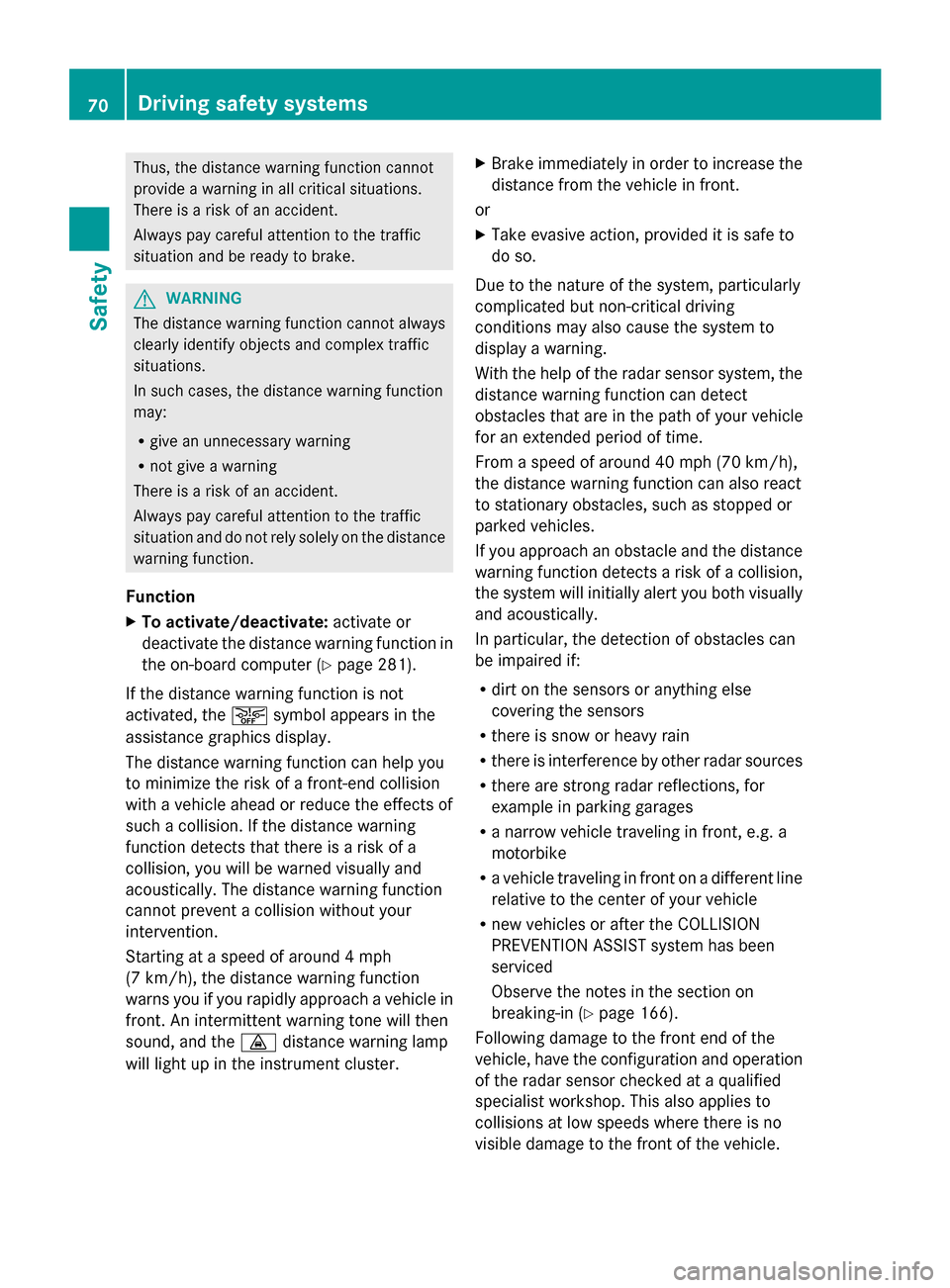
Thus, the distance warning function cannot
provide a warning in all critical situations.
There is a risk of an accident.
Always pay careful attention to the traffic
situation and be ready to brake. G
WARNING
The distance warning function cannot always
clearly identify objects and complex traffic
situations.
In such cases, the distance warning function
may:
R give an unnecessary warning
R not give a warning
There is a risk of an accident.
Always pay careful attention to the traffic
situation and do not rely solely on the distance
warning function.
Function
X To activate/deactivate: activate or
deactivate the distance warning function in
the on-board computer (Y page 281).
If the distance warning function is not
activated, the æsymbol appears in the
assistance graphics display.
The distance warning function can help you
to minimize the risk of a front-end collision
with a vehicle ahead or reduce the effects of
such a collision. If the distance warning
function detects that there is a risk of a
collision, you will be warned visually and
acoustically. The distance warning function
cannot prevent a collision without your
intervention.
Starting at a speed of around 4 mph
(7 km/h), the distance warning function
warns you if you rapidly approach a vehicle in
front. An intermittent warning tone will then
sound, and the ·distance warning lamp
will light up in the instrument cluster. X
Brake immediately in order to increase the
distance from the vehicle in front.
or
X Take evasive action, provided it is safe to
do so.
Due to the nature of the system, particularly
complicated but non-critical driving
conditions may also cause the system to
display a warning.
With the help of the radar sensor system, the
distance warning function can detect
obstacles that are in the path of your vehicle
for an extended period of time.
From a speed of around 40 mph (70 km/h),
the distance warning function can also react
to stationary obstacles, such as stopped or
parked vehicles.
If you approach an obstacle and the distance
warning function detects a risk of a collision,
the system will initially alert you both visually
and acoustically.
In particular, the detection of obstacles can
be impaired if:
R dirt on the sensors or anything else
covering the sensors
R there is snow or heavy rain
R there is interference by other radar sources
R there are strong radar reflections, for
example in parking garages
R a narrow vehicle traveling in front, e.g. a
motorbike
R a vehicle traveling in front on a different line
relative to the center of your vehicle
R new vehicles or after the COLLISION
PREVENTION ASSIST system has been
serviced
Observe the notes in the section on
breaking-in (Y page 166).
Following damage to the front end of the
vehicle, have the configuration and operation
of the radar sensor checked at a qualified
specialist workshop. This also applies to
collisions at low speeds where there is no
visible damage to the front of the vehicle. 70
Driving safety systemsSafety
Page 73 of 462
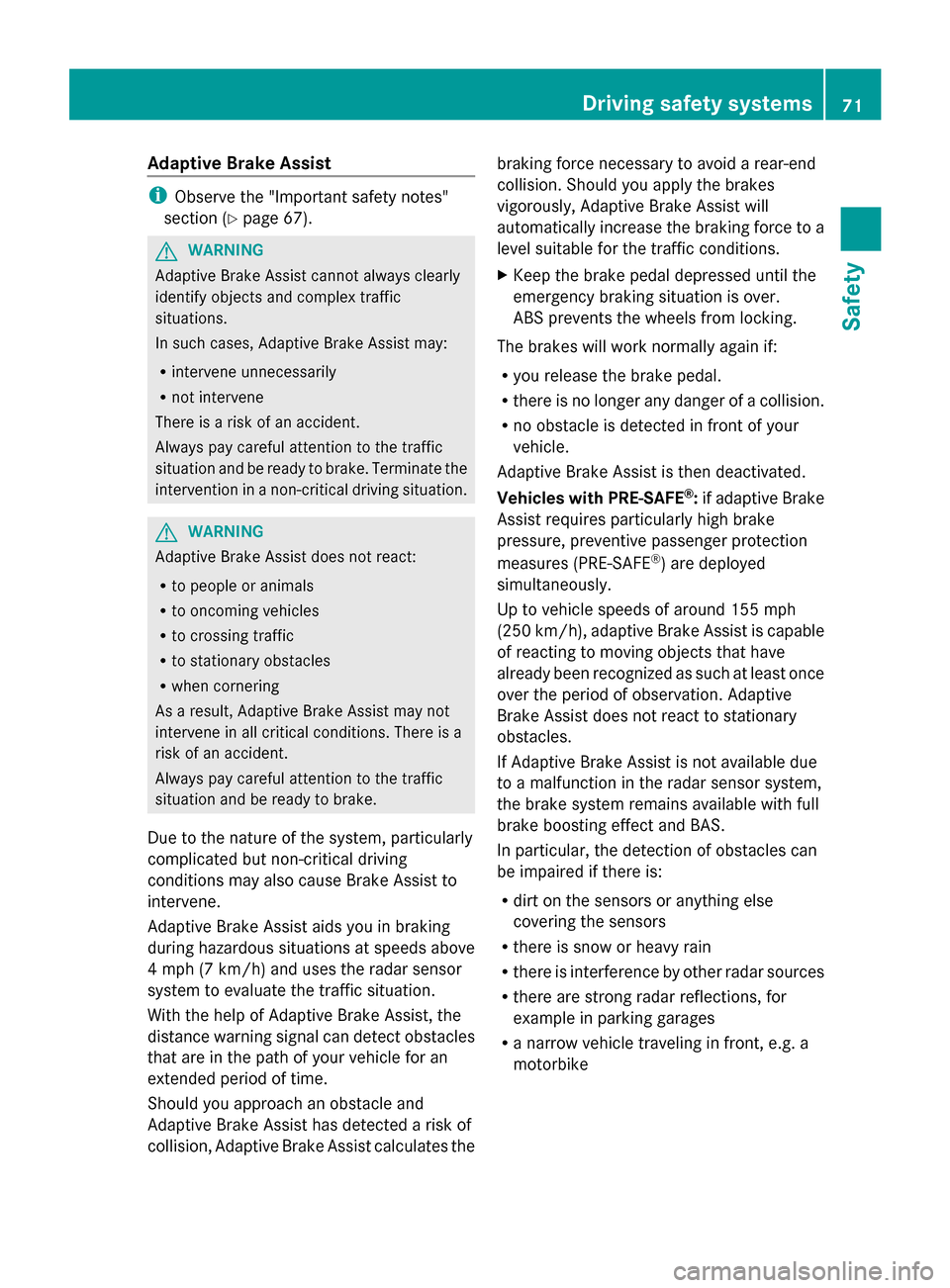
Adaptive Brake Assist
i
Observe the "Important safety notes"
section (Y page 67). G
WARNING
Adaptive Brake Assist cannot always clearly
identify objects and complex traffic
situations.
In such cases, Adaptive Brake Assist may:
R intervene unnecessarily
R not intervene
There is a risk of an accident.
Always pay careful attention to the traffic
situation and be ready to brake. Terminate the
intervention in a non-critical driving situation. G
WARNING
Adaptive Brake Assist does not react:
R to people or animals
R to oncoming vehicles
R to crossing traffic
R to stationary obstacles
R when cornering
As a result, Adaptive Brake Assist may not
intervene in all critical conditions. There is a
risk of an accident.
Always pay careful attention to the traffic
situation and be ready to brake.
Due to the nature of the system, particularly
complicated but non-critical driving
conditions may also cause Brake Assist to
intervene.
Adaptive Brake Assist aids you in braking
during hazardous situations at speeds above
4 mph (7 km/h) and uses the radar sensor
system to evaluate the traffic situation.
With the help of Adaptive Brake Assist, the
distance warning signal can detect obstacles
that are in the path of your vehicle for an
extended period of time.
Should you approach an obstacle and
Adaptive Brake Assist has detected a risk of
collision, Adaptive Brake Assist calculates the braking force necessary to avoid a rear-end
collision. Should you apply the brakes
vigorously, Adaptive Brake Assist will
automatically increase the braking force to a
level suitable for the traffic conditions.
X
Keep the brake pedal depressed until the
emergency braking situation is over.
ABS prevents the wheels from locking.
The brakes will work normally again if:
R you release the brake pedal.
R there is no longer any danger of a collision.
R no obstacle is detected in front of your
vehicle.
Adaptive Brake Assist is then deactivated.
Vehicles with PRE-SAFE ®
:if adaptive Brake
Assist requires particularly high brake
pressure, preventive passenger protection
measures (PRE-SAFE ®
) are deployed
simultaneously.
Up to vehicle speeds of around 155 mph
(250 km/h), adaptive Brake Assist is capable
of reacting to moving objects that have
already been recognized as such at least once
over the period of observation. Adaptive
Brake Assist does not react to stationary
obstacles.
If Adaptive Brake Assist is not available due
to a malfunction in the radar sensor system,
the brake system remains available with full
brake boosting effect and BAS.
In particular, the detection of obstacles can
be impaired if there is:
R dirt on the sensors or anything else
covering the sensors
R there is snow or heavy rain
R there is interference by other radar sources
R there are strong radar reflections, for
example in parking garages
R a narrow vehicle traveling in front, e.g. a
motorbike Driving safety systems
71Safety Z